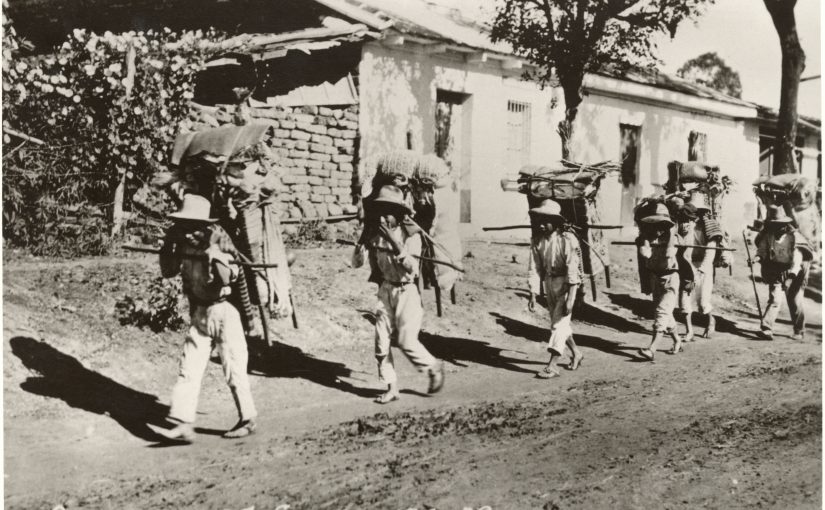In this lesson we will learn to speak about events in the past. In K’iche’ these are expressed using the completive aspect, which is comparable, though not the same as the past tense.
Mauricio le nub’i. Kimpe pa le tinamit Austin, pa le amaq’ Estados Unidos. In tijoxel pa le nimatijob’al. Iwir ximb’e pa le nimatijob’al. Aretaq xinwa’lijik, xinwa’ik. K’a te k’u ri’, ximb’e pa le nimatijob’al. Xinb’inik. Utz kinwil le nutinamit. Aretaq xinopan pa le nimatijob’al, xojb’e pa le qatijonik rech k’iche’. Tat Wel ub’i’ le qajtij. Pa le tijonik, xojch’aw ruk’ le qajtij pa k’iche’ ch’ab’al. Sib’alaj utz kinwil le nutijonik rech K’iche’!
My name is Mauricio. I am from the city of Austin in the United States. I am a student at the university. Yesterday I went to the university. When I got up, I ate. Then I went to school. I walked. I like my town. When I arrived at school, we went to K’iche’ class. My teacher’s name is tat Wel. In class, we talk with our teacher. I like my K’iche’ class a lot!
In K’iche’ the completive aspect indicates that the action is completed relative to the time spoken about. Remember that aspect gives us a text internal perspective of time, how events relate to each other: completive marks events that have been completed relative to other events. We generally translate the completive with the past in English (I went).
The completive marker is the prefix x-, which replaces the incompletive k(a)-. In the completive there is no filler vowel –a- in the third person singular, linking the aspect marker with the verb stem, like in the incompletive aspect.
| 1. K-at-b’ek INC-2sing- go You go. |
1. x-at-b’ek COMP-2sing-go You went. |
| 2. Ka-Ø-b’ek. INC-3sing- go He/she/it goes. |
2. x-Ø-b’ek COMP-3sing-go He/she/it went. |
| 3. x-im-b’ek. COMP-1sing-go I went. |
4. x-im-b’e r-uk’ le ajkun iwir COMP-1sing ART. doctor yesterday. I went to the doctor’s yesterday. |
| 4. La x-tzalij la iwir? INT COMP-return (2sing, formal) yesterday Did you return yesterday? |
5. Je’, x-in-tzalij-ik. Yes, COMP-1sing-return-pfm. Yes, I returned. |
The pronouns and phrase final markers are the same as for incompletive verbs.
| Completive Aspect | Person (set B) | Root | Phrase-final marker | Full form | Gloss |
| x- | m/in | b’e | -k | I went | |
| x- | at | b’e | -k | You went | |
| x- | Ø | b’e | -k | He/she/it went | |
| x- | — | b’e | — | You (formal) went | |
| x- | oj | b’e | -k | We went | |
| x- | ix | b’e | -k | You all went | |
| x- | e | b’e | -k | They went | |
| x- | — | b’e | — | You all (formal) went |
| wa’kat(ik) | to stroll, to take a walk |
| q’ij | day |
| amaq’ | country |
| k’a te k’u ri’ | then, after |
| E-uk’ | with (E- = ergative) |
| oq'(ik) | to cry |
| ul(ik) | to arrive (here) |
| kolotajik* | salvation |
| kos(ik) | to be tired, to tire |
| muqik* | burial |
| jiq'(ik) | to suffocate |
| qatat, qanan; qati’t, qamam | our ancestors (literally: our fathers, our mothers; our grandmothers, our grandfathers) |
| tukinel(ab’) | destroyer(s) |
| sokotajik* | wound |
| ch’ojin(ik) | to fight |
| poroj(ik) | to burn |
| uxlab’ | breath |
| tz’olq’omij | remorse, penance, regret |
| b’uk’uwem | the beating of the earth |
| matam | late |
| aretaq | when |
*These are in a grammatical form that we have not studied yet, where the root of a verb is used to make a noun. We will learn this form later.
Translate the following sentences into English:
- Xinwa’kat pa le juyub’ iwir.
- Matam xatwalij kamik.
- Xki’kot le al María aretaq xulik.
- La xatb’e pa le tyox iwir?
- La xixkos pa le ichak?
- Xojb’e pa le amaq’ Estados Unidos.
- -La xixul pa le tijob’al?
-Je’, xojulik. - La war le tijoxel pa le tijonik?
- Xojch’awik.
- Xch’aw le ajtij ruk’ le al We’l.

